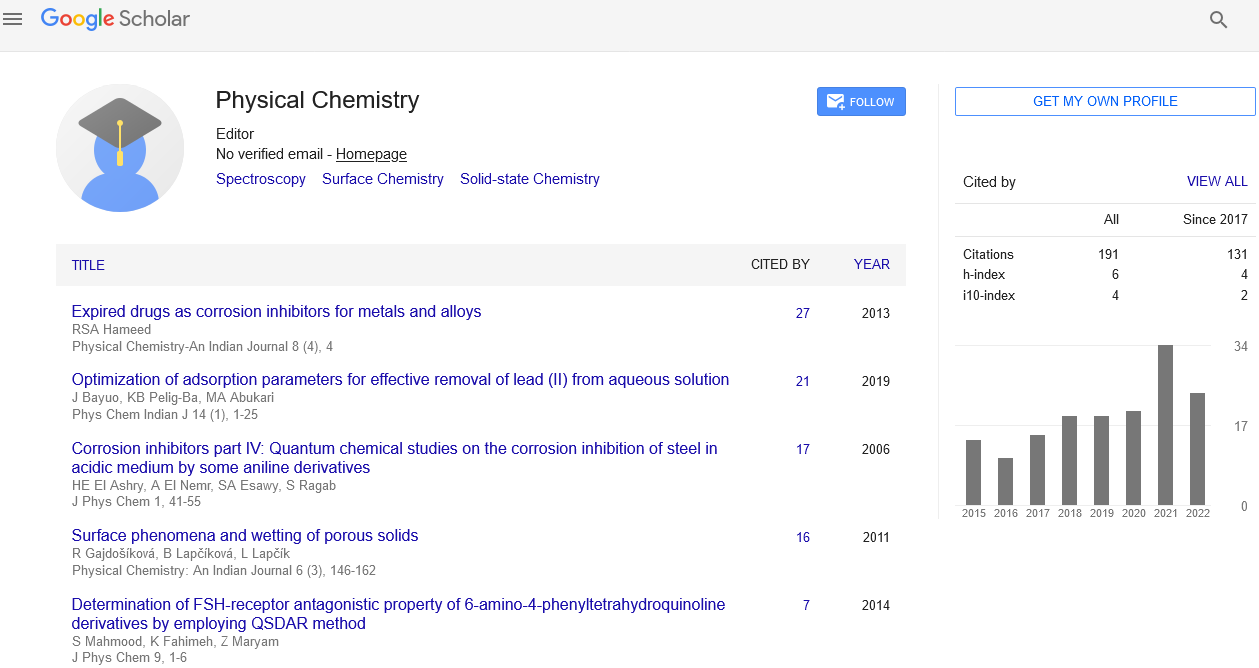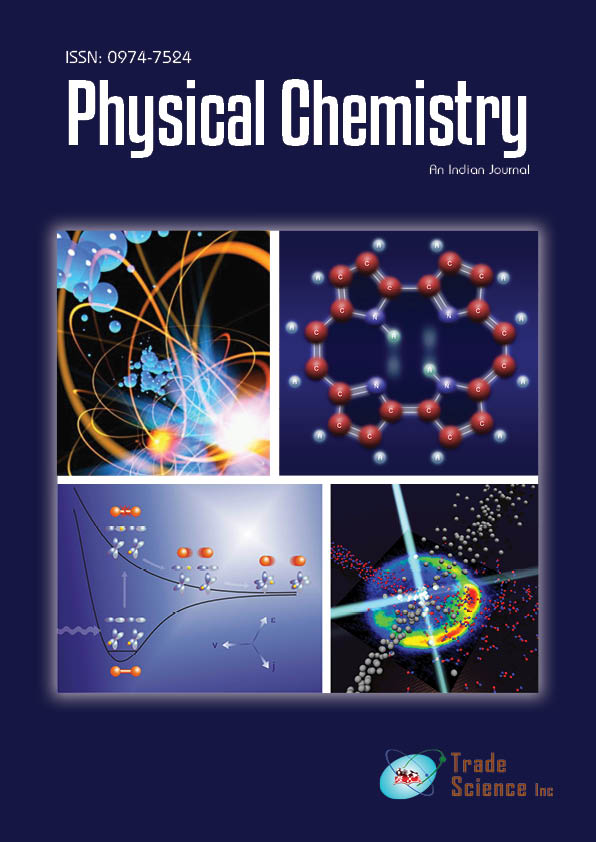Short communication
, Volume: 17( 1)Chromatography: Techniques of Separation
Jacob Taylor *
- *Correspondence:
- Jacob Taylor
Editorial Office,
Physcal Chemstry: An Indian Journal,
United Kingdom,
E-mail: physicalchem@journalres.com
Received: January 9, 2022; Accepted: January 13, 2022; Published: January 25, 2022
Citation: Taylor J. Chromatography: Techniques of Separation. Phys Chem Ind J. 2022;17(1):161.
Abstract
Chromatography is a significant biophysical technique for qualitative and quantitative analysis that allows for the separation, identification, and purification of the components of a mixture. Size and shape, total charge, hydrophobic groups on the surface, and binding capacity with the stationary phase are all factors that can be used to purify proteins. Ion exchange, surface adsorption, partition, and size exclusion are four separation approaches based on molecule properties and interaction type. Column, thin layer, and paper chromatography are examples of chromatography procedures that use a stationary bed. One of the most prevalent methods of protein purification is column chromatography
Introduction
Chromatography uses the principle of molecules in a mixture being applied to a surface or a solid, and the fluid stationary phase (stable phase) separating from one another while moving with the help of a mobile phase. Molecular features connected to adsorption (liquid-solid), partition (liquid-solid), and affinity or variations among their molecular weights are effective on this separation process. Some components of the mixture linger longer in the stationary phase and move slowly through the chromatographic system as a result of these differences, while others flow quickly into the mobile phase and leave the system faster [1]. The basic component efficient in separating molecules from each other is the type of interaction between the stationary phase, mobile phase, and substances contained in the mixture. Small molecules such as amino acids, carbohydrates, and fatty acids can be separated and identified using partition chromatography procedures. Affinity chromatography (also known as ion-exchange chromatography) is more successful at separating macromolecules such as nucleic acids and proteins [2]. Paper chromatography is used to separate proteins and in studies involving protein synthesis; gas-liquid chromatography is used to separate alcohol, ether, lipid, and amino groups, as well as to observe enzymatic interactions; and molecular-sieve chromatography is used to determine protein molecular weights. For purification, agarosegel chromatography is used for the RNA, DNA particles, and virus’s purification.
Stationary phase in chromatography is a solid phase or a liquid phase coated on the surface of a solid phase. Mobile phase flowing over the stationary phase is a gaseous or liquid phase. If mobile phase is liquid it is termed as liquid chromatography (LC), and if it is gas then it is called gas chromatography (GC). Gas chromatography is applied for gases, and mixtures of volatile liquids, and solid material [3]. Liquid chromatography is used especially for thermal unstable and non-volatile samples. Types of Chromatography- Column chromatography, Ion-exchange chromatography, Gel-permeation (molecular sieve) chromatography, Affinity chromatography, Paper chromatography, Thin-layer chromatography, Gas chromatography, Dye-ligand chromatography, hydrophobic interaction chromatography, Pseudo affinity chromatography, High-pressure liquid chromatography (HPLC).
Discussion
Column chromatography- Because proteins differ in size, shape, net charge, stationary phase utilized, and binding capability, each of these distinguishing characteristics can be isolated using chromatographic procedures. Column chromatography is the most commonly used method among these. Purification of biomolecules is accomplished using this method. On a column (stationary phase), the sample to be separated is applied first, followed by wash buffer (mobile phase). Their flow is ensured by the interior column material, which is positioned on a fiberglass support. The samples are gathered in a time- and volumedependent way at the device's bottom [4].
Ion- exchange chromatography- Electrostatic interactions between charged protein groups and solid support material underpin ion-exchange chromatography (matrix). The ion load of the matrix is opposite that of the protein to be separated, and the protein's affinity for the column is obtained by ionic connections. Proteins are separated from the column by altering the buffer solution's pH, ion salt concentration, or ionic strength. Anion-exchange matrices are positively charged ionexchange matrices that adsorb negatively charged proteins [5]. Cation-exchange matrices bind negatively charged groups and adsorb positively charged proteins.
Gel- permeation (molecular sieve) chromatography- The primary premise of this technology is to separate macromolecules based on their differences in molecular sizes using dextran-containing materials. This method is primarily used to quantify protein molecular weights and lower salt concentrations in protein solutions. The stationary phase of a gel-permeation column is made up of inert molecules with small pores [6]. The solution, which contains molecules of various sizes, is constantly fed through the column at a steady flow rate. Molecules larger than pores are unable to infiltrate into gel particles and are trapped between them within a defined space. Larger molecules penetrate between porous particles and move quickly through the interior of the column.
Affinity chromatography- Enzymes, hormones, antibodies, nucleic acids, and particular proteins are purified using this chromatography technology [7]. The column's filling material is bound by a ligand that can form a compound with a certain protein (dextran, polyacrylamide, cellulose, etc.). While free proteins leave the column, the specific protein that forms a complex with the ligand is bound to the solid support (matrix) and kept in the column. The bound protein is then released from the column by altering its ionic strength (by changing the pH or adding a salt solution). Paper chromatography- The support material in paper chromatography is a layer of cellulose that has been soaked with water. The support in this method was thick filter paper, and the stationary "liquid phase" was water drops settled in its pores. A suitable fluid is introduced in a developing tank during the mobile phase. A "liquid-liquid" chromatography is paper chromatography [8].
Thin-layer chromatography- Thin-layer chromatography is a type of chromatography that uses "solid-liquid adsorption." A solid adsorbent material placed on glass plates serves as the stationary phase in this approach. All solid substances used in column chromatography (alumina, silica gel, cellulose) can be employed as adsorbent material. The mobile phase climbs upward through the stationary phase in this manner. By capillary action, the solvent rises up the thin plate that has been soaked in it. It also propels the mixture previously dropped on the bottom regions of the plate with a pipette upwards with varying flow rates during this procedure [9]. The separation of analyses is thus accomplished. The polarity of the substance, solid phase, and solvent all influence the upward transit rate. Gas chromatography- The stationary phase in this method is a column that is inserted into the device and includes a liquid stationary phase that is adsorbed onto the surface of an inert solid. Gas chromatography is a type of chromatography that uses both gas and liquid. Gases such as Helium or N2 constitute the carrier phase. Under high pressure, the mobile phase, which is an inert gas, is passed through a column. The vaporized sample enters a gaseous mobile phase. On the solid support, the components in the sample are spread between the mobile phase and the stationary phase. Gas chromatography is a straightforward, versatile, highly sensitive, and quick-to-apply technology for separating extremely small compounds [10].Dye- ligand chromatography- The capacity of various enzymes to bind purine nucleotides for Cibacron Blue F3GA dye was demonstrated during the development of this technology. The structure of NAD is similar to that of a planar ring with negatively charged groups. The binding of Cibacron Blue F3GA dye to the adenine, ribose binding sites of NAD has demonstrated this connection. The dye works in the same way that ADPribose does. This type of adsorbent has a binding capacity that is 10–20 times more than that of other adsorbent.
The adsorbed proteins are separated from the column utilizing the ion-exchange property of the adsorbent and appropriate pH conditions, elution with high-ionic strength solutions, and the ion-exchange property of the adsorbent [11]. Hydrophobic interaction chromatography (HIC)- Adsorbents manufactured as column material for affinity chromatography's ligand binding are employed in this procedure. Hydrophobic interactions between sides chains bonded to the chromatographic matrix provide the basis for the HIC technology. Pseudo-affinity chromatography- Because of their affinity for dehydrogenases, kinases, transferases, and reductases, some chemicals such as anthraquinonoid dyes and azo-dyes can be employed as ligands. Immobilized metal affinity chromatography is the most well-known kind of this sort of chromatography. High-pressure liquid chromatography- It is possible to undertake structural and functional analysis as well as purification of numerous compounds using this chromatography technology in a short amount of time [12]. Amino acids, carbohydrates, lipids, nucleic acids, proteins, steroids, and other physiologically active substances can all be separated and identified using this technology. In HPLC, the mobile phase flows through the columns at a high pace (0.1 cm/sec to 5 cm/sec) and at a pressure of 10atm-400 atm. The employment of small particles and high pressure on the rate of solvent flow in this approach boosts the separation power of HPLC, and the analysis is performed in a short period.
The chromatography technique is a powerful tool for biochemists, and it is very simple to use in clinical laboratory tests. Paper chromatography, for example, is used to identify sugars and amino acids in physiological fluids that are linked to genetic metabolic diseases. In laboratories, gas chromatography is used to measure steroids, barbiturates, and lipids. Vitamins and proteins are separated using the chromatographic process [13].
Conclusion
As with natural pigments, chromatographic techniques were initially utilized to isolate compounds based on their hue. Its application field has grown significantly over time. Chromatography is now well recognized as a very sensitive and effective separation technique. One of the most useful separation and determination methods is column chromatography. Column chromatography is a protein purification technology that is based on one of proteins' distinguishing characteristics. Furthermore, these techniques are employed to ensure that a protein's purity is maintained. HPLC can purify amino acids, proteins, nucleic acids, hydrocarbons, carbohydrates, medicines, antibiotics, and steroids, among other things, because to its increased sensitivity, rapid turnover rate, and usage as a quantitative approach.

